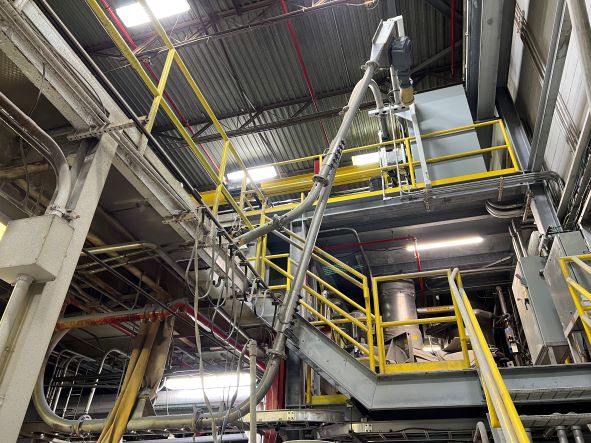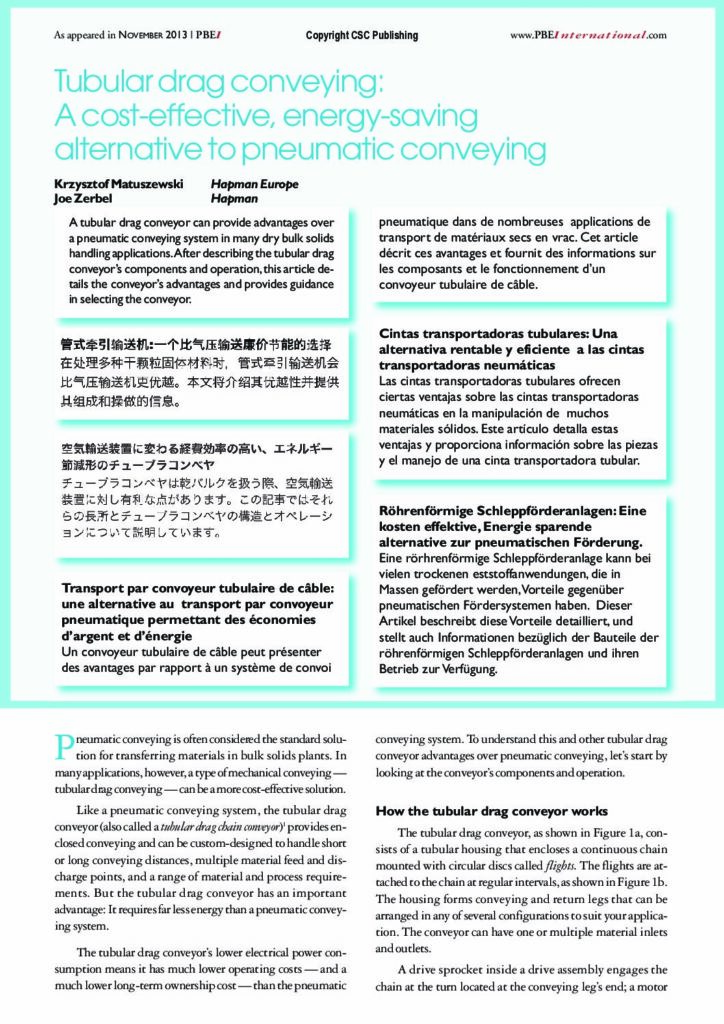
Pneumatic conveying is often considered the standard solution for transferring materials in bulk solids plants. In many applications, however, a type of mechanical conveying — tubular drag conveying — can be a more cost-effective solution. Like a pneumatic conveying system, the tubular drag conveyor (also called a tubular drag chain conveyor) provide enclosed conveying and can be custom-designed to handle short or long conveying distances, multiple material feed and discharge points, and a range of material and process requirements. But the tubular drag conveyor has an important advantage: It requires far less energy than a pneumatic conveying system.
The tubular drag conveyor’s lower electrical power consumption means it has much lower operating costs — and a much lower long-term ownership cost — than the pneumatic conveying system. To understand this and other tubular drag conveyor advantages over pneumatic conveying, let’s start by looking at the conveyor’s components and operation.
How the Tubular Drag Conveyor Works
The tubular drag conveyor, consists of a tubular housing that encloses a continuous chain mounted with circular discs called flights. The flights are attached to the chain at regular intervals. The housing forms conveying and return legs that can be arranged in any of several configurations to suit your application. The conveyor can have one or multiple material inlets and outlets.
A drive sprocket inside a drive assembly engages the chain at the turn located at the conveying leg’s end; a motor nylon, cast iron, ductile iron, stainless steel, and other materials. UHMW-PE flights are recommended for most applications because they’re durable yet lightweight, they have a low cost, and they provide quick release of sticky materials, without wearing the conveyor bends and housing like steel or iron flights can.
More about the housing. The tubular housing can be made of carbon steel or stainless steel and is available in various diameters between 76 and 305 millimeters (3 and 12 inches). Which diameter best meets your needs depends on your required conveying capacity. Housing sections are provided in lengths to suit your conveyor’s layout and have bolted and gasketed flanged ends to allow easy field installation and maintain the conveyor’s tight seal.
More about conveying capacity. The tubular drag conveyor can move material at up to 1.416m3/min (50 ft3/min). The conveying capactiy depends on the tubular housing diameter, the distance between flights, and the chain speed. Average material conveying capacities are shown for each housing diameter within the PDF. However, be aware that the recommended conveying speed for a given application varies with the material type, and this will affect the conveyor’s actual conveying capacity.
Consuming Far Less Energy
The tubular drag conveyor requires much less power, making it much cheaper to operate than a pneumatic conveying system. The pneumatic system has several components that require a large amount of electrical power. The large motor for the system’s fan or blower consumes most of this power. If the system operates in dense phase, it has a pressure tank that requires a large amount of compressed air — another major energy draw. Motors for the system’s rotary valves require additional power. More electrical power is drawn by the compressed-air system supplying filter-cleaning air to the system’s filter-receiver.
In contrast, the tubular drag conveyor typicallyhas one small motor for its drive assembly. The motor’s variable-speed drive also mitigates spikes in energy use, reducing the conveyor’s overall energy requirement. As an example, the fan in a high-capacity pressure pneumatic conveying system can require a 100-horsepower motor, while the tubular drag conveyor’s drive assembly would require only a 15-horsepower motor to provide the same capacity.
More Advantages
Besides consuming less power, the tubular drag conveyor has other advantages over a pneumatic conveying system. Slow gentle handling. Material is moved more slowly in the tubular drag conveyor than in a pneumatic conveying system. Because the material is conveyed in the spaces between the flights, it’s also handled gently. This slow, gentle movement keeps blended materials from segregating and prevents degradation of fragile or friable materials.
Tolerance for tough materials and fluctuating environmental conditions. Because the material is carried between the flights, it’s much easier to convey sluggish, sticky materials and easily compacted materials in the tubular drag conveyor than in a pneumatic conveying system, where such materials can form plugs. Fluctuating temperatures and humidity also have less effect on the tubular drag conveyor’s operation than that of a pneumatic conveying system.
No filters. Very little air (or other gas) moves through the tubular drag conveyor, so it doesn’t require filters. A pneumatic conveying system requires a filter-receiver and other filters at various points in the system.
Lower inert gas requirement. The minimal amount of gas moving through the tubular drag conveyor provides another advantage: In an application that requires blanketing a flammable or explosive material with an inert gas such as nitrogen, the tubular drag conveyor uses a fraction of the inert gas consumed by a comparably sized pneumatic conveying system.
Less noise. The tubular drag conveyor’s small motor and slow conveying speed make it much quieter than a pneumatic conveying system. The pneumatic conveying system’s large fan or blower motor and other motors produce a lot of noise. More noise is created by the intermittent blasts of compressed air for the filter-receiver’s cleaning system and, for a dense-phase system, compressor operation for filling the pressure tank.
Less maintenance. Because the tubular drag conveyor has far fewer components, it requires much less maintenance than a pneumatic conveying system. With the pneumatic conveying system, the system fan or blower, rotary valves, and filter-receiver (and its filter-cleaning system) all require regular maintenance. With the tubular drag conveyor, maintenance workers will need to replace the flights at intervals that depend on the application, and also minimize slack in the chain, ideally about once a month. (Be aware that while some tubular drag chain conveyor suppliers offer automatic chain-tensioning devices, tensioning the chain can accelerate flight wear and increase the conveyor’s amp draw and power consumption.) The tubular drag conveyor’s slow conveying speed also extends the conveyor life. Less maintenance means the tubular drag conveyor can operate more reliably with less downtime and lower labor costs.
Modular construction. Most tubular drag conveyors have modular construction with interchangeable components that allow the conveyor to be easily expanded or reconfigured to change the length, conveying path, and the number of inlets and outlets. Such changes are more complex and time-consuming with a pneumatic conveying system because it has many more components and more electrical connections.
Some Selection Guidance
For help choosing a tubular drag conveyor to handle your unique material and process requirements, partner with the conveyor supplier. You’ll benefit from the supplier’s many years of experience in designing tubular drag conveyors to handle a wide range of tough materials and operating conditions.
Start by providing information about your material’s characteristics, especially particle size, bulk density, and flow properties. The supplier will also need to know application details such as your plant’s available floor space and headroom, how your material will be stored prior to conveying, the distance your material will be conveyed, the available energy source, and similar information. A key part of this process is to have your material tested in a tubular drag conveyor in the supplier’s lab. Based on the test results, the supplier can help you determine which conveyor components and options are right for your application.
